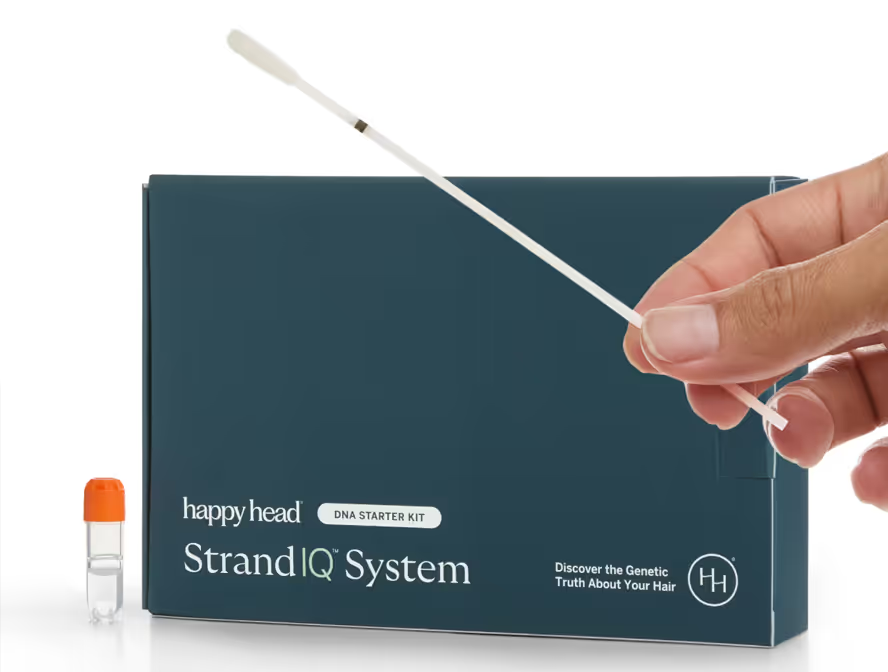Glutathione is often referred to as the master antioxidant—and for good reason. Produced primarily in the liver, it plays a crucial role in defending cells against oxidative stress. This is particularly important for hair follicles, which are among the body’s most metabolically active tissues and constantly exposed to stressors such as pollution, UV light, inflammation, and the natural aging process.
In the scalp, glutathione helps maintain a healthy follicular environment by:
- neutralizing reactive oxygen species (ROS) before they can damage follicle cells
- recycling other antioxidants like vitamin C and vitamin E, which further protect hair structures
- supporting cellular detoxification pathways that remove harmful byproducts
- regulating inflammatory responses, which can impact follicle health over time
When glutathione levels are consistently low, follicles become more vulnerable to oxidative damage. Over time, this can lead to slower growth rates, reduced scalp resilience, and progressive thinning.
The Role Genetics Play in Glutathione Deficiency
While lifestyle factors such as diet, stress, and toxin exposure influence glutathione levels, genetics play a substantial role in determining your baseline production and recycling capacity.
Key genetic factors include:
- Variants in glutamate-cysteine ligase (GCL) – This enzyme catalyzes the rate-limiting step in glutathione synthesis. Variants can reduce the efficiency of glutathione production even when adequate dietary building blocks are available.
- Glutathione S-transferases (GSTs) – This family of enzymes uses glutathione to detoxify harmful compounds. Certain variants can alter enzyme activity, affecting how quickly glutathione is consumed under stress.
- Solute-carrier (SLC) transport genes – These regulate how glutathione and its precursors are transported into cells, including those in the scalp. Reduced transport efficiency can lower cellular glutathione despite normal blood levels.
If you carry one or more of these variants, your hair follicles may experience chronic oxidative stress more readily, especially in high-pollution environments or during periods of illness, injury, or inflammation.
Using tools like Happy Head’s StrandIQ analysis to understand your genetic predisposition can help you create a targeted hair health plan that includes nutrient support, lifestyle adjustments, and, if appropriate, professional monitoring of antioxidant status.
Recommendations Based on Genetic Risk
These strategies can help support glutathione production, recycling, and activity at each level of genetic risk.
Low Risk: Maintain Healthy Production
If your StrandIQ genetic profile suggests that you’re at a low risk for glutathione deficiency, your goal is to keep glutathione production steady through a balanced diet and moderate lifestyle habits.
- Adequate protein intake
Include poultry, fish, tofu, cheese, and legumes to supply cysteine, glycine, and glutamate—the building blocks of glutathione. - Vitamin C-rich foods
Oranges, bell peppers, strawberries, and kiwi help recycle oxidized glutathione back to its active form. - Regular, moderate exercise
While physical activity boosts production, you should avoid chronic overtraining, which can deplete glutathione reserves. - Minimize unnecessary toxin exposure
Limit smoking, excess alcohol, and high-pollution exposure when possible to reduce antioxidant demand.
Medium Risk: Support Both Production and Activation
If you have moderate genetic risk, your body may benefit from targeted nutritional and lifestyle interventions that increase both the amount and efficiency of glutathione.
- Protein-rich diet with variety
Incorporate beef, pork, poultry, fish, cheese, tofu, and legumes to provide complete amino acid profiles. - Add cruciferous vegetables
Broccoli, cauliflower, cabbage, bok choy, and Brussels sprouts contain sulforaphane, which can induce glutathione production pathways. - Structured exercise routine
Engage in regular movement without pushing into chronic high-intensity territory, which can cause oxidative overload. - Professional input before supplementation
Glutathione supplements and precursors such as N-acetylcysteine (NAC) may help but should be guided by a healthcare provider.
High Risk: Combine Diet, Recovery, and Medical Oversight
If your genetic profile indicates high risk for glutathione deficiency, a multi-layered approach can help protect hair follicles and scalp health.
- Daily protein and cruciferous vegetables
Consistency is key for maintaining a steady supply of glutathione precursors and activators. - Whey protein supplementation
A great option for increasing the amount and efficacy of glutathione, whey protein contains cysteine in a form that can directly enhance glutathione synthesis. - Optimize recovery
Prioritize sleep, as glutathione regeneration peaks during deep rest phases. - Professional antioxidant monitoring
Work with your Happy Head care team to receive periodic assessment of oxidative stress markers as antioxidant status can guide adjustments. - Supplementation with supervision
If recommended by your doctor, consider NAC, alpha-lipoic acid, or liposomal glutathione.
Path Forward for Supporting Glutathione and Hair Health
Glutathione is central to maintaining a healthy, growth-friendly scalp environment. When your genetic makeup limits production or recycling efficiency, oxidative stress can accumulate quickly, leading to slower regrowth, weaker strands, and diminished scalp resilience.
By understanding your genetic risk and implementing targeted dietary and lifestyle strategies, you can reduce oxidative burden, protect follicle health, and support long-term hair vitality. Whether your risk is low or high, consistent daily actions—from nutrition to recovery—play a pivotal role in optimizing glutathione activity.
Resources
StrandIQ SNP Marker Count: 7
StrandIQ Genes for Trait:
DNTTIP2, GCLC, GCLC-AS1, GCLM, GPX1, GSTP1, RHOA
References:
Grussy, K., et al. (2023). The importance of polymorphisms in the genes encoding glutathione S-transferase isoenzymes in development of selected cancers and cardiovascular diseases. Molecular Biology Reports, 50, 9649–9661. PMID: 37862954.
Maes, O. C., et al.(2010). A GSTM3 polymorphism associated with an etiopathogenetic mechanism in Alzheimer disease. Neurobiology of Aging, 31(1), 34–45. PMID: 18423940.
Polonikov, A., et al. (2022). The impact of genetic polymorphisms in glutamate–cysteine ligase, a key enzyme of glutathione biosynthesis, on ischemic stroke risk and brain infarct size. Life, 12(4), 602. PMID: 35455093.
Wang, C., et al. (2020). Association between glutathione peroxidase-1 (GPX1) Rs1050450 polymorphisms and cancer risk. BioMed Research International, 2020, 4057160. PMID: 31966829.
Yadav, P., Chatterjee, A., & Bhattacharjee, A. (2014). Identification of deleterious nsSNPs in α, μ, π and θ class of GST family and their influence on protein structure. Genomics Data, 2, 66–72. PMID: 26484073.
This content, including StrandIQ™ DNA analysis reports and any Happy Head products and/or services referenced therein, is for informational and cosmetic purposes only. It is not intended to diagnose, treat, cure, or prevent any disease. This content does not constitute medical advice and should not be used to make healthcare decisions. References to prescription treatments are educational in nature. Always consult a licensed healthcare professional for any medical concerns or treatment decisions.








.avif)

